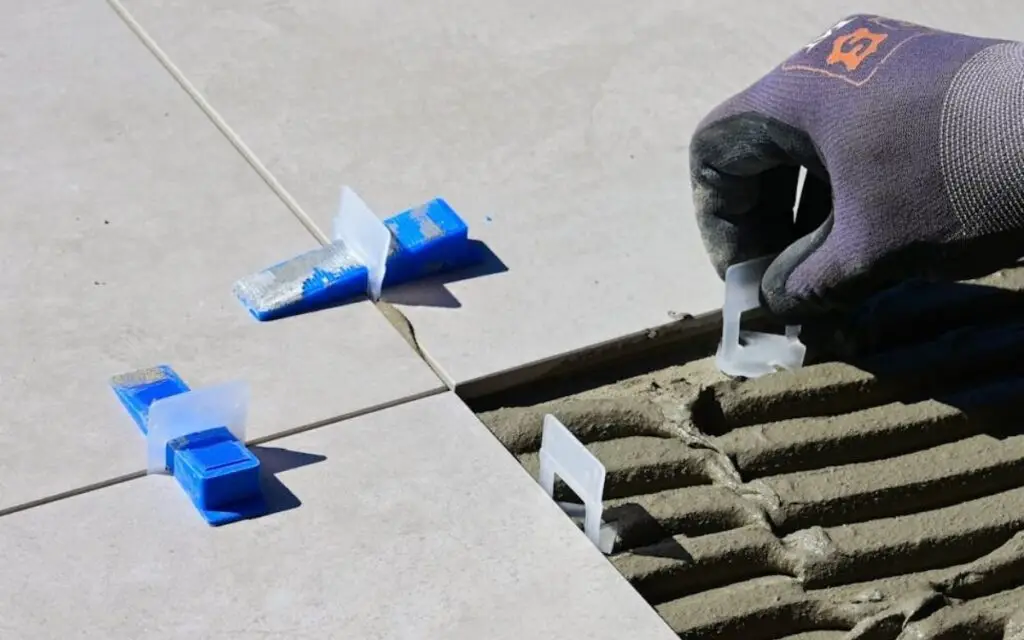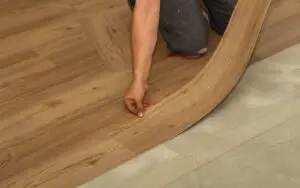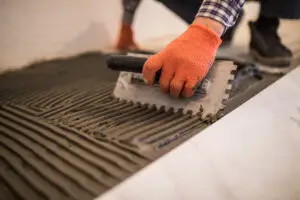Understanding the 50% Tile Pattern
What is a 50% Offset Pattern?
Definition and Appearance
A 50% offset pattern, also known as a brick or running bond pattern, involves laying tiles so that each row is offset by half the length of the tile from the row above or below. This creates a staggered, brick-like appearance that is often sought after for a classic, traditional look. However, it is important to note that while the look might be appealing to some, the inherent challenges often outweigh the benefits.
Common Misconceptions
Many homeowners mistakenly believe that a 50% offset pattern is the best way to achieve a visually interesting tile layout. While the pattern is definitely a design choice, it’s essential to understand that this pattern is more likely to magnify even the slightest imperfections in the tiles or subfloor. These issues can lead to an unprofessional final result, which is why professional installers often advise against using this pattern.
Why It’s Not Recommended
Increased Risk of Lippage
The most significant reason why the 50% offset pattern is not recommended is that it greatly increases the risk of lippage, which is when one tile sits higher than its adjacent tile. This is due to the fact that any slight variation in tile size or flatness becomes amplified with this pattern, leading to uneven surfaces. The higher the level of lippage, the more pronounced these variations will appear.
Alignment Issues
Another challenge associated with a 50% offset pattern is the increased difficulty in achieving perfect alignment. Any slight variation in tile size or spacing will become much more apparent, as the eyes tend to easily pick up on these types of inconsistencies. Minor misalignment issues can quickly turn into a major eyesore in the finished product. Professional installers know how to avoid these problems by choosing better layout patterns, or by using proper tile installation techniques.
Problems with the 50% Offset Pattern
Lippage: What It Is and Why It’s Bad
How Uneven Tile Can Impact Quality
Lippage significantly impacts the quality of a tile installation. When tiles are not perfectly flush, it creates an uneven surface that can be unsightly and difficult to clean. This is not only an aesthetic issue, but also impacts the durability of the tile. The uneven surfaces can also create pressure points that can cause the tiles to chip, crack or break, requiring costly repairs in the future.
Potential Hazards and Discomfort
Beyond the aesthetic concerns, lippage can also be a safety hazard. Uneven tiles create tripping hazards, especially in areas with heavy foot traffic. Additionally, the uneven surface can be uncomfortable to walk on. Professional installers are trained to mitigate these hazards and make sure the tiling project is both beautiful and safe.
Difficulties in Installation
Subfloor Imperfections Amplified
The 50% offset pattern amplifies any imperfections present in the subfloor. If the subfloor is not perfectly level, the staggered layout will highlight these imperfections, resulting in a final product that looks uneven and unprofessional. Proper subfloor preparation is crucial for a successful tile project, and it is often a lot of extra work for even the most experienced DIYer.
Cutting and Alignment Challenges
The 50% offset pattern also makes cutting and aligning tiles more challenging. Because of the offset, more cuts are needed, and any error in cutting or spacing will become much more obvious. The complex cuts, combined with the increased risk of misalignment, make this pattern particularly difficult for DIY installers. Professional installers are highly skilled in tile installation and know the best patterns to use, while still providing the best aesthetics, and without the hassle.
Alternative Tile Patterns
Recommended Patterns for Tile Installation
1/3 Offset or Less
A 1/3 offset pattern, where each tile is offset by one-third of its length, is generally recommended over the 50% offset. This pattern helps to minimize lippage and is much more forgiving in terms of alignment, resulting in a more consistent and even surface. This is one of the most common tile layout patterns used by professionals.
Stacked Patterns
A stacked or grid pattern, where tiles are laid directly in line with each other, is another excellent alternative. This pattern avoids the lippage issues of the offset patterns and creates a clean, modern look. Stacked patterns are great for large format tiles and are very easy to install, even for inexperienced installers.
Benefits of Using Alternative Patterns
Reduced Risk of Lippage
Alternative patterns, like the 1/3 offset or the stacked pattern, significantly reduce the risk of lippage. These patterns are more forgiving and provide a more consistent finish, resulting in a professional result that looks great and lasts a long time. Professionals often recommend these patterns for their reliability and beauty.
Easier Installation Process
The alternative patterns are also much easier to install, and are less prone to error than the 50% pattern. With fewer cuts and simpler alignment requirements, these patterns can save time and effort while still producing a professional final product. This makes them a great choice for both DIYers and professional installers.
DIY vs. Professional Tile Installation: Pattern Matters
Challenges for DIYers with 50% Pattern
Inconsistent Results
DIYers often struggle to achieve consistent results when using a 50% offset pattern. The increased risk of lippage and alignment issues often lead to a final product that looks amateurish and may even require costly repairs in the future. Due to the difficulty and potential for issues, it is best for most DIYers to avoid this pattern.
Costly Mistakes
DIY tile installation with a 50% offset pattern can be more expensive in the long run due to the higher risk of mistakes, and the possibility of having to replace damaged materials, or even the complete job. Often, the cost of fixing these mistakes can end up being higher than hiring a professional installer in the first place.
Advantages of Professional Tiling Services
Expertise in Tile Patterns
Professional tile installers have the knowledge and expertise to guide clients on the best tile patterns for each project. They know which patterns are more prone to error and which provide the best results in all situations. They use this knowledge to provide a high-quality and long-lasting tile installation.
Ensuring Flawless Installation
Professional installers use proper techniques and tools to ensure a flawless tile installation. This includes meticulously preparing the subfloor, using the right adhesive and grout, and paying close attention to pattern and alignment. This results in an extremely well-done tiling job, that looks great and lasts a long time.
Case Studies: 50% Pattern vs. Recommended Patterns
Example of Uneven 50% Pattern
A homeowner attempted a DIY tile installation with a 50% offset pattern. Due to minor imperfections in the tiles and an uneven subfloor, the finished product had noticeable lippage, uneven grout lines, and it was uncomfortable to walk on. This homeowner then had to hire a professional to fix their mistakes.
Example of a Smooth 1/3 Offset Pattern
Another homeowner hired a professional tile installer who recommended a 1/3 offset pattern. The professional installer prepped the subfloor correctly, and the result was a beautifully tiled area with no lippage, even grout lines, and a comfortable, flat surface. This is the result that most homeowners desire, and that a professional installer will always deliver.
FAQs & Answers
The 50% offset pattern is problematic because it exaggerates any minor variations in tile size and flatness. This can cause lippage, where one tile sits higher than the next, which not only looks unprofessional but can also be a tripping hazard. Additionally, the 50% pattern makes any subfloor imperfections more noticeable. Professionals know to avoid this pattern and advise against it due to its inherent installation risks.
Lippage refers to the unevenness between adjacent tiles, where one tile edge sits higher than the next. It’s a very important issue that impacts the quality and safety of the tile installation. Lippage can make walking uncomfortable, and it can also cause your newly installed tiles to look amateurish. Professional installers take great care to ensure a flat, even tile surface, which will provide you with a beautiful and safe environment.
While there are extremely rare situations where a 50% offset might work, these would be for extremely specific scenarios and only when using perfectly calibrated tiles. Even when using the highest quality tiles, the increased chance for lippage makes it generally inadvisable. The risks of using this pattern almost always outweigh the benefits, which is why it is often avoided by professional installers.
When it comes to avoiding lippage, patterns with a 30% or less offset are usually recommended, as these patterns minimize unevenness, and provide a more balanced look. Another great option is to use a stacked pattern, where the tiles are laid directly in line with each other. These types of patterns are more forgiving and are often used by professionals for a smooth, flat finish.
Professional tile installers are trained in proper installation techniques to ensure a smooth and flawless result. This includes carefully inspecting tiles for imperfections, using the correct tools, preparing the subfloor appropriately, choosing recommended patterns, and paying close attention to alignment and spacing. They also have the experience to choose the correct patterns for each space. These practices, combined with their expertise, makes the result beautiful and long-lasting.





